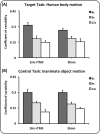The cerebellum predicts the temporal consequences of observed motor acts
- PMID: 25689858
- PMCID: PMC4331528
- DOI: 10.1371/journal.pone.0116607
The cerebellum predicts the temporal consequences of observed motor acts
Abstract
It is increasingly clear that we extract patterns of temporal regularity between events to optimize information processing. The ability to extract temporal patterns and regularity of events is referred as temporal expectation. Temporal expectation activates the same cerebral network usually engaged in action selection, comprising cerebellum. However, it is unclear whether the cerebellum is directly involved in temporal expectation, when timing information is processed to make predictions on the outcome of a motor act. Healthy volunteers received one session of either active (inhibitory, 1 Hz) or sham repetitive transcranial magnetic stimulation covering the right lateral cerebellum prior the execution of a temporal expectation task. Subjects were asked to predict the end of a visually perceived human body motion (right hand handwriting) and of an inanimate object motion (a moving circle reaching a target). Videos representing movements were shown in full; the actual tasks consisted of watching the same videos, but interrupted after a variable interval from its onset by a dark interval of variable duration. During the 'dark' interval, subjects were asked to indicate when the movement represented in the video reached its end by clicking on the spacebar of the keyboard. Performance on the timing task was analyzed measuring the absolute value of timing error, the coefficient of variability and the percentage of anticipation responses. The active group exhibited greater absolute timing error compared with the sham group only in the human body motion task. Our findings suggest that the cerebellum is engaged in cognitive and perceptual domains that are strictly connected to motor control.
Conflict of interest statement
Figures




References
-
- Schmahmann JD, Caplan D (2006) Cognition, emotion and the cerebellum. Brain 129: 290–292. - PubMed
-
- Timmann D, Daum I (2007) Cerebellar contributions to cognitive functions: A progress report after two decades of research. Cerebellum 6: 159–162. - PubMed
-
- Ivry RB, Spencer RM (2004) The neural representation of time. Curr Opin Neurobiol. 14: 225–232. - PubMed
MeSH terms
LinkOut - more resources
Full Text Sources
Other Literature Sources

